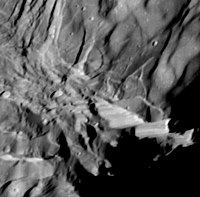Miranda (moon)

| |||||||
| Discovery | |||||||
|---|---|---|---|---|---|---|---|
| Discovered by | Gerard P. Kuiper | ||||||
| Discovered in | February 16, 1948 | ||||||
| Orbital characteristics | |||||||
| Mean radius | 129,872 km | ||||||
| Eccentricity | 0.0013 | ||||||
| Orbital period | 1.413479 d | ||||||
| Inclination | 4.232° (to Uranus' equator) | ||||||
| Is a satellite of | Uranus | ||||||
| Physical characteristics | |||||||
| Mean diameter | 471.6 km (480×468.4×465.8 km) | ||||||
| Surface area | 2,790,000 km2 | ||||||
| Volume | 54,835,000 km3 | ||||||
| Mass | 6.59×1019 kg | ||||||
| Mean density | 1.20 g/cm3 | ||||||
| Surface gravity | 0.079 m/s2 | ||||||
| Escape velocity | 0.19 km/s | ||||||
| Rotation period | synchronous | ||||||
| Axial tilt | zero | ||||||
| Albedo | 0.32 | ||||||
| Surface temp. |
| ||||||
| Atmospheric pressure | 0 kPa | ||||||
Miranda (mi-ran'-da) is the smallest and innermost of Uranus' major moons.
It was discovered by Gerard Kuiper on 1948-02-16 at Fort Davis. It is named after Prospero's daughter in William Shakespeare's play The Tempest. It is also designated Uranus V.
So far the only close-up images of Miranda are from the Voyager 2 probe, which made observations of the moon during its Uranus flyby in January, 1986. During the flyby the southern hemisphere of the moon was pointed towards the Sun so only it was studied. It was a fortunate coincidence that the moon passed by at the closest distance by Voyager 2 turned out to be the geologically most active body in the Uranus system.
Physical characteristics

Miranda's surface may be mostly water ice, with the low density body being made of silicate rock and methane-related organic compounds. Miranda's surface is criss-crossed by huge canyons up to 20 kilometres (12 miles) deep, with patchwork regions of broken terrain indicating intense geological activity in the moon's past. Large grooved structures, called coronae, may be the result of upwelling warm ice. It is thought that this activity is powered by tidal forces from Uranus. Another theory, now considered less likely, suggests that Miranda was at some point struck by a massive object that shattered the moon. Fragments then resettled into different positions forming the current strange pattern.
Miranda's orbital inclination (4.34°) is unusually high for a body so close to the planet. It is possible that it was at some point in a 3:1 orbital resonance with Umbriel. Resulting tidal friction may also have caused warming within the moon and thus be the culprit of the geological activity.
Scientists recognize the following geological features on Miranda:
- Craters
- Coronae (large ovoid features)
- Regiones (geological regions)
- Rupes (scarps)
- Sulci (parallel grooves)
